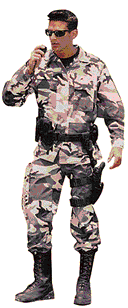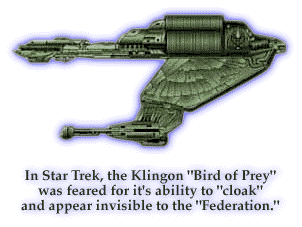

Now you see me - now you don't!
 In the early part of World War II, a group of Naval Admirals and officials from the War Department watched in disbelief as an assortment of illustrations was presented by a special team that had been commissioned to camouflage naval ships. The Naval gray and blue ships were easily spotted against the horizon and made excellent targets, their silhouettes contrasting with the bright sky. The illustration and models were anything but mute. The single color battleships and destroyers were depicted with bold zebra stripes and highly contrasted bands of white and black. One Admiral remarked that the so called camouflage reminded him of striped prison clothes, designed to be noticed, and the meeting ended with some cigar smoke and a few jokes. In the early part of World War II, a group of Naval Admirals and officials from the War Department watched in disbelief as an assortment of illustrations was presented by a special team that had been commissioned to camouflage naval ships. The Naval gray and blue ships were easily spotted against the horizon and made excellent targets, their silhouettes contrasting with the bright sky. The illustration and models were anything but mute. The single color battleships and destroyers were depicted with bold zebra stripes and highly contrasted bands of white and black. One Admiral remarked that the so called camouflage reminded him of striped prison clothes, designed to be noticed, and the meeting ended with some cigar smoke and a few jokes.But what started out as a joke was, in fact, the brilliant beginning of a new science which had made advances in camouflage through carefully studying the animal kingdom and human perception. Like the African zebras, whose highly visible black and white stripes hardly seem the best way to hide, these patterns have been demonstrated to confuse and blend in to tall grass and bush at a distance. It is not so much that they are invisible but that their exact shapes and outlines become complicated to discern from the surrounding shapes and patterns. At some point in the Cold War, the British commissioned a study on how best to camouflage tanks, the primary weapon in a NATO European conflict. Several colors were tested but all failed to disguise the tanks when back lit by a sunny sky on the changing battlefield horizon. One crazy idea, though, worked almost perfectly. British engineers had covered a tank with hundreds of light bulbs whose illumination could be varied. When these lights were adjusted to the ambient light level of the back-lit sky, the tank was virtually invisible to a distant observer even with the use of binoculars. In recent years, may UFO sightings have reported the apparent disappearance of circular craft in broad daylight, preceded by what appeared to be adjustments made to its surface luminescence. The popular 1980's television series Star Trek had an invisible field generator scripted in to the Klingon (an often hostile alien race) battleships, often surprising Captain Kirk and crew when they suddenly "decloaked" near the starship. Epic mysteries like "The Philadelphia Experiment." where the US Navy is alleged to have made an entire battleship disappear in the harbor, in full view of hundreds of witnesses, by using some type of radio frequency waves, have fueled the mystery of invisibility. Now, years later, the science of invisibility - of cloaking people and machines - has leaped to the present: Enter Project Chameleo.
High-speed processors, improved video chips and lighter, more detailed display panels now allow for stationary or moving vehicles - even soldiers - to be cloaked. What's more, because these cloaking images are able to be "stored" (like any digital image) or projected "live" there is the potential to "call up" various scenes like vegetation or naturally occurring rock formations, as well as "live" projections of the background, to make "blending in" as perfect and easy as the reptile that the Project Chameleo was named after. At present, records indicate that video camouflage for a tank or fighter jet would cost about 10 million dollars each. Some unexpected cost saving benefits have been found. Because the displays can be made to change from light to dark, their ability to reflect heat and thus maintain cooling inside such vehicles as tanks has been an added bonus and an energy saver. Universally applied to these typically "hot" vehicles, Project Chameleo could save energy cooling costs by as much as 8 billion dollars.
If these systems are implemented by the military and private security sectors, this could potentially mean as much as 20 billion dollars in production contracts spread across the US over the next five years. This type of mass-production would dramatically reduce the cost of such display panels and bring their civilian use to an affordable range. Some of the current hesitation with this system stems from the perception that such display devices are fragile and subject to flickering, but Project Chameleo documents show that this problem is easily overcome with present existing technology. Project Chameleo currently holds the patents for this new cloaking technology and their success in marketing and finding new and unimagined applications for this technology will doubtless change the face of our world in the future. And what about those wild and gaudy battleships? A US. Naval Engineer said that the stealthy requirements of large battleships now must include radar and heat cloaking but he suggested that a system like the Project Chameleo could be useful for smaller craft or covert reconnaissance. Technology is approaching the point where the display panels do not need not be flat, like those in laptops. Configurations of curved or even flexible screens may soon allow for clothing and other unusual surfaces to be visually transformed by this same technology. The image of the soldier in such a "cloaking uniform" (above) is not as far off as you may think. Letting your imagination travel through the future, it is possible that entire buildings could be transformed into natural murals (or, more likely, unavoidable advertisements). Someday surfing the internet may involve environmental adventures within special digital "rooms" paneled with these same displays... Our dingy apartments or bedrooms could be the ultimate things to camouflage, transforming them into a sunny beach or a panoramic download from the surface of Mars.
For more information on this technology and Project Chameleo,
|
 According to Executive Summaries, Project Chameleo's new cloaking device is designed to conceal an object by placing a thin video screen between the observer and the object being concealed, at the same time, presenting a full color image of the background scene to the viewer. The illusion is that the viewer can see "through" the object being cloaked.
According to Executive Summaries, Project Chameleo's new cloaking device is designed to conceal an object by placing a thin video screen between the observer and the object being concealed, at the same time, presenting a full color image of the background scene to the viewer. The illusion is that the viewer can see "through" the object being cloaked. 